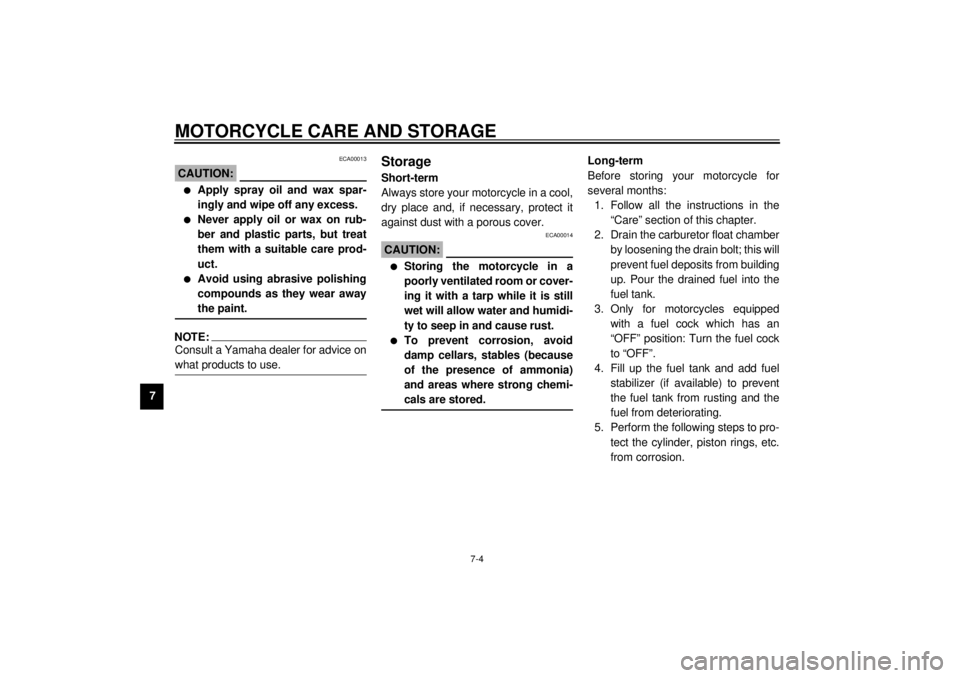Page 65 of 78

7-1
7
EAU01518
7-MOTORCYCLE CARE AND STORAGE
CareThe exposure of its technology makes
a motorcycle charming but also vulner-
able. Although high-quality compo-
nents are used, they are not all rust-re-
sistant. While a rusty exhaust pipe may
remain unnoticed on a car, it does look
unattractive on a motorcycle. Frequent
and proper care, however, will keep
your motorcycle looking good, extend
its life and maintain its performance.
Moreover, the warranty states that the
vehicle must be properly taken care of.
For all these reasons, it is recommend-
ed that you observe the following
cleaning and storing precautions.Before cleaning
1. Cover up the muffler outlet with a
plastic bag.
2. Make sure that all caps and covers
as well as all electrical couplers
and connectors, including the
spark plug cap, are tightly in-
stalled.
3. Remove extremely stubborn dirt,
like oil burnt onto the crankcase,
with a degreasing agent and a
brush, but never apply such prod-
ucts onto seals, gaskets, sprock-
ets, the drive chain and wheel
axles. Always rinse the dirt and
degreaser off with water.Cleaning
After normal use
Remove dirt with warm water, a neutral
detergent and a soft clean sponge,
then rinse with plenty of clean water.
Use a tooth or bottle brush for hard-to-
reach parts. Tougher dirt and insects
will come off more easily if the area is
covered with a wet cloth for a few min-
utes before cleaning.
E_3mw.book Page 1 Monday, February 5, 2001 9:54 AM
Page 66 of 78

MOTORCYCLE CARE AND STORAGE
7-2
7
ECA00010
CAUTION:@ l
Avoid using strong acidic wheel
cleaners, especially on spoked
wheels. If you do use such
products for hard-to-remove
dirt, do not leave it on any long-
er than instructed, then thor-
oughly rinse it off with water,
immediately dry the area and
apply a corrosion protection
spray.
l
Improper cleaning can damage
windshields, cowlings, panels
and other plastic parts. Use
only a soft, clean cloth or
sponge with mild detergent and
water to clean plastic.
l
Do not use any harsh chemical
products on plastic parts. Be
sure to avoid using cloths or
sponges which have been in
contact with strong or abrasive
cleaning products, solvent or
thinner, fuel (gasoline), rust re-
movers or inhibitors, brake flu-
id, antifreeze or electrolyte.
l
Do not use high-pressure wash-
ers or steam-jet cleaners since
they cause water seepage and
deterioration in the following ar-
eas: seals (of wheel bearings,
swingarm bearings, forks and
brakes), electric components
(couplers, connectors, instru-
ments, switches and lights),
breather hoses and vents.
l
For motorcycles equipped with
a windshield: Do not use strong
cleaners or hard sponges as
they will cause dulling or
scratching. Some cleaning
compounds for plastic may
leave scratches on the wind-
shield. Test the product on a
small hidden part of the wind-
shield to make sure they do not
leave any marks. If the wind-
shield is scratched, use a quali-
ty plastic polishing compound
after washing.
@
E_3mw.book Page 2 Monday, February 5, 2001 9:54 AM
Page 67 of 78

MOTORCYCLE CARE AND STORAGE
7-3
7 After riding in the rain, near the sea or
on salt-sprayed roadsSince sea salt or salt sprayed on the
roads in the winter are extremely corro-
sive in combination with water, carry
out the following steps after each ride
in the rain, near the sea or on salt-
sprayed roads. (Salt sprayed in the
winter may remain on the roads well
into spring.)
1. Clean your motorcycle with cold
water and soap after the engine
has cooled down.
ECA00012
CAUTION:@ Do not use warm water since it in-
creases the corrosive action of the
salt. @2. Be sure to apply a corrosion pro-
tection spray on all (even chrome-
and nickel-plated) metal surfaces
to prevent corrosion.After cleaning
1. Dry the motorcycle with a chamois
or an absorbing cloth.
2. Immediately dry the drive chain
and lubricate it to prevent it from
rusting.
3. Use a chrome polish to shine
chrome, aluminum and stainless-
steel parts, including the exhaust
system. (Even the thermally in-
duced discoloring of stainless-
steel exhaust systems can be re-
moved through polishing.)
4. To prevent corrosion, it is recom-
mended to apply a corrosion pro-
tection spray on all (even chrome-
and nickel-plated) metal surfaces.
5. Use spray oil as a universal clean-
er to remove any remaining dirt.
6. Touch up minor paint damage
caused by stones, etc.
7. Wax all painted surfaces.
8. Let the motorcycle dry completely
before storing it or covering it.
EWA00001
WARNING
@ Make sure that there is no oil or wax
on the brakes and tires. If neces-
sary, clean the brake discs and lin-
ings with a regular brake disc
cleaner or acetone, and wash the
tires with warm water and mild soap.
Then, carefully test the motorcycle
for its braking performance and cor-
nering behavior. @
E_3mw.book Page 3 Monday, February 5, 2001 9:54 AM
Page 68 of 78

MOTORCYCLE CARE AND STORAGE
7-4
7
ECA00013
CAUTION:@ l
Apply spray oil and wax spar-
ingly and wipe off any excess.
l
Never apply oil or wax on rub-
ber and plastic parts, but treat
them with a suitable care prod-
uct.
l
Avoid using abrasive polishing
compounds as they wear away
the paint.
@NOTE:@ Consult a Yamaha dealer for advice on
what products to use. @
StorageShort-term
Always store your motorcycle in a cool,
dry place and, if necessary, protect it
against dust with a porous cover.
ECA00014
CAUTION:@ l
Storing the motorcycle in a
poorly ventilated room or cover-
ing it with a tarp while it is still
wet will allow water and humidi-
ty to seep in and cause rust.
l
To prevent corrosion, avoid
damp cellars, stables (because
of the presence of ammonia)
and areas where strong chemi-
cals are stored.
@
Long-term
Before storing your motorcycle for
several months:
1. Follow all the instructions in the
“Care” section of this chapter.
2. Drain the carburetor float chamber
by loosening the drain bolt; this will
prevent fuel deposits from building
up. Pour the drained fuel into the
fuel tank.
3. Only for motorcycles equipped
with a fuel cock which has an
“OFF” position: Turn the fuel cock
to “OFF”.
4. Fill up the fuel tank and add fuel
stabilizer (if available) to prevent
the fuel tank from rusting and the
fuel from deteriorating.
5. Perform the following steps to pro-
tect the cylinder, piston rings, etc.
from corrosion.
E_3mw.book Page 4 Monday, February 5, 2001 9:54 AM
Page 69 of 78

MOTORCYCLE CARE AND STORAGE
7-5
7 a. Remove the spark plug cap and
spark plug.
b. Pour a teaspoonful of engine oil
into the spark plug bore.
c. Install the spark plug cap onto the
spark plug and place the spark
plug on the cylinder head so that
the electrodes are grounded. (This
will limit sparking during the next
step.)
d. Turn the engine over several times
with the starter. (This will coat the
cylinder wall with oil.)
e. Remove the spark plug cap from
the spark plug, install the spark
plug and then the spark plug cap.
EWA00003
WARNING
@ When turning the engine over, be
sure to ground the spark plug elec-
trodes to prevent damage or injury
from sparking. @
6. Lubricate all control cables and
the pivoting points of all levers and
pedals as well as of the sidestand/
centerstand.
7. Check and, if necessary, correct
the tire air pressure, then raise the
motorcycle so that both of its
wheels are off the ground. Alterna-
tively, turn the wheels a little every
month in order to prevent the tires
from becoming degraded in one
spot.
8. Cover up the muffler outlet with a
plastic bag to prevent moisture
from entering.9. Remove the battery and fully
charge it. Store it in a cool, dry
place and recharge it once a
month. Do not store the battery in
an excessively cold or warm place
(less than 0 °C or more than
30 °C). For more information, see
“Battery storage” in the chapter
“PERIODIC MAINTENANCE AND
MINOR REPAIRS”.
NOTE:@ Make any necessary repairs before
storing the motorcycle. @
E_3mw.book Page 5 Monday, February 5, 2001 9:54 AM
Page 70 of 78

8-1
8
EAU01038
8-SPECIFICATIONSSpecifications
Model SR125
Dimensions
Overall length 2,020 mm
Overall width 775 mm
Overall height 1,100 mm
Seat height 745 mm
Wheelbase 1,285 mm
Ground clearance 155 mm
Minimum turning radius 2,100 mm
Basic weight (with oil and full
fuel tank)
113 kg
Engine
Engine type Air-cooled 4-stroke, SOHC
Cylinder arrangement Forward-inclined single cylinder
Displacement 124 cm
3
Bore ´ Stroke 57.0 ´ 48.8 mm
Compression ratio 10:1
Starting system Electric starter
Lubrication system Wet sumpEngine oil
Ty p e
Recommended engine oil
classification API Service SE, SF, SG type or
higher
Quantity
Periodic oil change 1.0 L
With oil filter replacement 1.1 L
Total amount 1.3 L
Air filterWet type element
-20˚ -10˚ 0˚
10˚20˚ 30˚
40˚50˚C
SAE 10W/30
SAE 15W/40SAE 20W/40SAE 20W/50
SAE 10W/40
CAUTION:Be sure to use motor oils that do not contain anti-friction
modifiers. Passenger car motor oils (often labeled
“Energy Conserving”) contain anti-friction additives which
will cause clutch and/or starter clutch slippage, resulting in
reduced component life and poor engine performance.
E_3mw.book Page 1 Monday, February 5, 2001 9:54 AM
Page 71 of 78
SPECIFICATIONS
8-2
8
Fuel
Type Regular unleaded gasoline
Fuel tank capacity 10.0 L
Fuel reserve amount 1.6 L
Carburetor
Type ´ quantity Y24P ´ 1
Manufacturer TEIKEI
Spark plug
Manufacturer/Type NGK / DR8EA
Gap 0.6 ~ 0.7 mm
Clutch typeWet, multiple-disc
Transmission
Primary reduction system Spur gear
Primary reduction ratio 3.318
Secondary reduction system Chain drive
Secondary reduction ratio 3.500
Number of drive chain
sprocket teeth (rear/front) 49/14
Transmission type Constant mesh 5-speed
Operation Left foot operationGear ratio
1st 2.250
2nd 1.476
3rd 1.125
4th 0.926
5th 0.793
Chassis
Frame type Diamond
Caster angle 26°45¢
Trail 90 mm
Tires
Front
Type With tube
Size 3.00-17 45P
Manufacturer/
model Inoue / 8F
Rear
Type With tube
Size 3.50-16 52P
Manufacturer/
model Inoue / 8RA
E_3mw.book Page 2 Monday, February 5, 2001 9:54 AM
Page 72 of 78
SPECIFICATIONS
8-3
8
Maximum load* 160 kg
Air pressure (cold tire)
Up to 90 kg load*
Front 175 kPa (1.75 kg/cm
2, 1.75 bar)
Rear 200 kPa (2.00 kg/cm2, 2.00 bar)
90 kg load ~ maximum load*
Front 175 kPa (1.75 kg/cm2, 1.75 bar)
Rear 225 kPa (2.25 kg/cm2, 2.25 bar)
*Load is total weight of cargo, rider, passenger and accessories
Wheels
Front
Type Spoke
Size 17 ´ 1.60
Rear
Type Spoke
Size 16 ´ 1.85
Brakes
Front
Type Single disc brake
Operation Right hand operation
Fluid DOT 4 or DOT 3
Rear
Type Drum brake
Operation Right foot operationSuspension
Front
Ty p e Te l e s c o p i c f o r k
Rear
Type Swingarm
Shock absorbers
Front Coil spring / oil damper
Rear Coil spring / oil damper
Wheel travel
Front 120 mm
Rear 76 mm
Electrical system
Ignition system C.D.I.
Charging system
Type C.D.I. magneto
Standard output 14 V, 9 A @ 5,000 r/min
Battery
Type 12N7-3B-1
Voltage, capacity 12 V, 7 AH
Headlight typeQuartz bulb (halogen)
E_3mw.book Page 3 Monday, February 5, 2001 9:54 AM